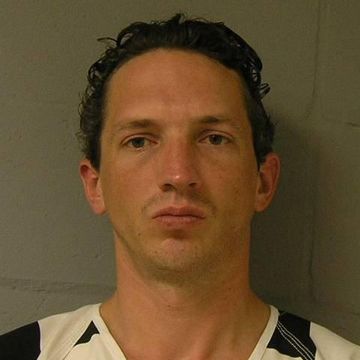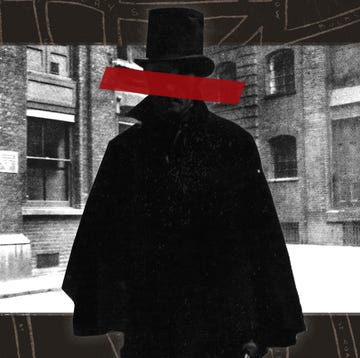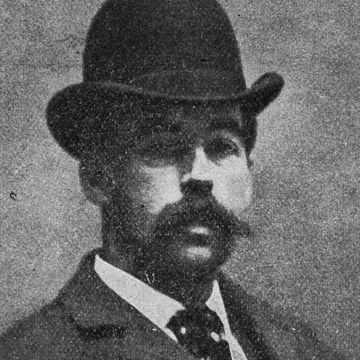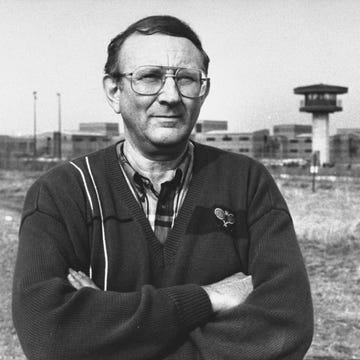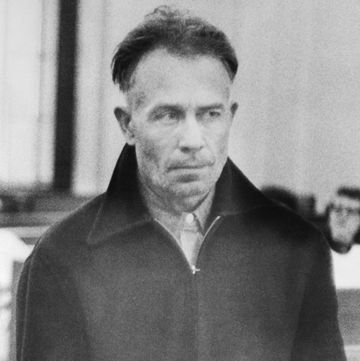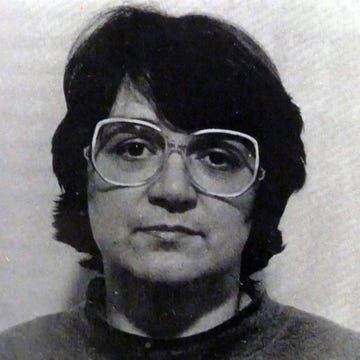1946-2020
Latest News: The Long Shadow Miniseries Depicts Serial Killer Peter Sutcliffe
The crimes of British serial killer Peter Sutcliffe, known as the “Yorkshire Ripper,” are the subject of the new ITV seven-part miniseries The Long Shadow. Featuring popular British actors like Toby Jones and David Morrissey, the series gives a dramatized portrayal of the arduous investigation behind Sutcliffe’s capture and the effects his heinous crimes had on survivors and his victims’ families.
Who Was Peter Sutcliffe?
British serial killer Peter Sutcliffe, known as the Yorkshire Ripper, killed at least 13 women and brutally assaulted seven others between 1975 and 1980. His earliest known attack was in 1969; that victim survived and didn’t press charges. Terror spread through northern England as Sutcliffe’s attacks continued, spurring a years-long manhunt that involved an estimated 2.5 million police hours. The investigation was riddled with problems, including disrespect for Sutcliffe’s victims who were sex workers and a hoax that misdirected police. Sutcliffe was finally arrested and convicted in 1981. The Yorkshire Ripper has attracted continued interest over the years, with his story being told in a true-crime podcast and in the 2020 Netflix documentary The Ripper. Sutcliffe died in November 2020 at age 74.
Quick Facts
FULL NAME: Peter William Sutcliffe
BORN: June 2, 1946
DIED: November 13, 2020
BIRTHPLACE: Bingley, West Yorkshire, England
SPOUSE: Sonia Szurma (1974-1994)
ASTROLOGICAL SIGN: Gemini
Early Life
Peter William Sutcliffe was born on June 2, 1946, in Bingley within England’s West Yorkshire county. His parents were John and Kathleen Sutcliffe. Peter grew up with five younger siblings, two brothers and three sisters, in a working-class Catholic family.
As a teenager, he was said to be a loner with voyeuristic tendencies. He left school in 1961, when he was 15, and afterward took on several different jobs, including at a factory and a mill. He became a grave digger in 1964, which led to a part-time job at a local morgue. He bragged to friends about robbing bodies at the morgue.
In 1976, Sutcliffe found a job as a truck driver. He became a trusted employee and remained in the position during his killing spree.
Victims
Beginning in the late 1960s, Sutcliffe was responsible for targeting at least 21 victims, 13 of whom he killed. Eight people survived his gruesome attacks with lasting trauma and severe injuries. He exclusively sought out women, usually sex workers, in Yorkshire and Manchester. Sutcliffe often battered his victims with a hammer, as well as stabbed and mutilated them with a knife or sharpened screwdriver. The bulk of his crimes occurred between 1975 and 1980. However, authorities have said Sutcliffe could be responsible for additional crimes and have investigated whether he is connected to unsolved cases.
Sutcliffe committed his first known attack in 1969. He used a sock with a stone in it to strike a woman. She survived but declined to press charges. Several years passed before he acted again.
The first woman Sutcliffe is known to have killed was 28-year-old Wilma McCann. She was a sex worker who he murdered in October 1975, and Sutcliffe later confessed to the police, “After that first time, I developed and played up a hatred for prostitutes in order to justify within myself a reason why I had attacked and killed Wilma McCann.” He killed another sex worker, 42-year-old Emily Jackson, in January 1976.
In 1977, Sutcliffe took the lives of four women: 28-year-old Irene Richardson in February, 32-year-old Patricia Atkinson in April, 16-year-old Jayne MacDonald in June, and 21-year-old Jean Jordan in October. Unlike his previous victims, MacDonald hadn’t engaged in sex work. This change in victim profile resulted in national press attention, and soon, the media was using the name the “Yorkshire Ripper” to describe the killer.
His three victims in 1978 were sex workers Yvonne Pearson, Helen Rytka, and Vera Millward. Sutcliffe killed Pearson, 22, and Rytka, 18, in separate attacks that January. He murdered Millward, 40, in May.
Sutcliffe waited nearly a year to claim his next victim. In April 1979, he killed Josephine Whittaker, a 19-year-old bank clerk. According to one police detective, “mass hysteria” ensued because more women felt threatened. Whittaker, who’d been killed while walking home, was seen as a “respectable” woman. Fears also heightened following the death of 20-year-old student Barbara Leach in September 1979.
Sutcliffe committed his 12th and 13th murders in 1980. He killed civil servant Marguerite Walls, 47, in August and a 20-year-old student named Jacqueline Hill in November.
After his capture, a 1982 government inquiry noted,“We feel it is highly improbable that the crimes in respect of which Sutcliffe has been charged and convicted are the only ones attributable to him.” A decade later, he reportedly confessed to striking a 14-year-old girl with a hammer in August 1975. In 2017, police admitted they were reviewing unsolved cases for ties to Sutcliffe. However, no additional charges were ever filed against him.
Problematic Investigation and Eventual Arrest
Sutcliffe himself said at his trial,“It was just a miracle they did not apprehend me earlier—they had all the facts.” But multiple investigatory missteps kept police from capturing the Yorkshire Ripper. One issue with the investigation was the sheer quantity of information. So many index cards were used that the rooms holding these cards needed reinforced floors. And at the time, there were no computers to process the facts contained on the cards.
Investigators missed other opportunities to stop the serial killer. Police interviewed Sutcliffe nine times prior to his arrest. In one encounter, no one spotted that he was wearing a pair of boots that matched a print left at the scene of one of his crimes. Nor did authorities follow up after a friend sent the police an anonymous letter denouncing Sutcliffe. When they traced a five-pound banknote discovered on one victim to Sutcliffe’s employer, police accepted Sutcliffe’s alibi that he had been at a party.
In 1979, police fell for a hoax tape and letters purportedly from the Yorkshire Ripper, a mistake that had deadly consequences. Sutcliffe had a Yorkshire accent, but the accent on the hoax recording led authorities to search for suspects outside of Yorkshire. Police bought into the hoax even as some survivors informed authorities that their assailant had spoken with a Yorkshire accent. Sutcliffe killed three additional victims between the hoax tape investigatory detour and his arrest.
Police also dismissed some victims who didn’t fit into their “prostitute killer” profile. This meant that when Marcella Claxton, who wasn’t a sex worker, survived an assault in May 1976, her testimony was ignored, along with the accurate sketch she’d helped create. In addition, police believed that the women Sutcliffe targeted had engaged in behavior—such as sex work, being out late at night, or drinking alone—that had attracted his attention, and they counseled women to either stay home at night or only go out with a trusted male escort.
When investigators finally accepted that the killer wasn’t solely targeting sex workers, one detective said Sutcliffe was now pursuing “innocent” victims. This attitude was also on display during Sutcliffe’s trial, when a prosecutor said of the victims,“Some were prostitutes, but perhaps the saddest part of the case is that some were not. The last six attacks were on totally respectable women.” Following Sutcliffe’s death in 2020, a police constable issued an apology “for the additional distress and anxiety caused to all relatives by the language, tone, and terminology used by senior officers at the time in relation to Peter Sutcliffe’s victims.”
Ultimately, Sutcliffe was arrested in the city of Sheffield on January 2, 1981. He was sitting in a car with a sex worker, Olivia Reivers, when police spotted his fake license plates. After he was taken into custody, police discovered screwdrivers in Sutcliffe’s car, which resulted in a search that uncovered a hammer and knife he stashed near the scene of his arrest. He’d gotten a private moment to do so by telling officers he needed to relieve himself. During his interrogation, Sutcliffe confessed to the crimes, saying,“It’s all right, I know what you’re leading up to. The Yorkshire Ripper. It’s me. I killed all those women.”
Trial and Sentence
Sutcliffe’s trial began on May 4, 1981. Although he’d confessed to being the Yorkshire Ripper after his January arrest, he pleaded guilty to manslaughter in court and not guilty to murder, claiming diminished responsibility (akin to a plea of temporary insanity in the United States). Sutcliffe shared that he’d killed sex workers due to his belief that he was on a “divine mission.”
Sutcliffe’s plea of diminished responsibility, which could have resulted in a lighter sentence, wasn’t successful. On May 22, 1981, he was found guilty of 13 murders and seven counts of attempted murder. The judge sentenced him to 20 life terms and recommended a minimum sentence of 30 years. The death penalty wasn’t an option, having been abolished in 1965.
After he was captured and behind bars, Sutcliffe began using his mother’s maiden name and going by Peter William Coonan. In 1984, a diagnosis of paranoid schizophrenia saw Sutcliffe removed from prison and sent to Broadmoor Hospital, a secure psychiatric facility. While in custody Sutcliffe applied for the right to parole, but a 2010 ruling said that he would never be released from prison. He was declared mentally able to leave the secure hospital and sent to a maximum-security prison in 2016.
Sutcliffe experienced numerous assaults while in custody. In 1997, an inmate stabbed Sutcliffe’s eyes with a pen, and he subsequently lost vision in his left eye.
Wife
Sutcliffe met Sonia Szurma, whose parents were refugees from Poland and Ukraine, in 1966. The two married on August 10, 1974. They had no children.
Sonia offered her support during Sutcliffe’s 1981 trial and initially visited him while he was in custody. They divorced in 1994. Her visits reportedly stopped after she got married again in 1997.
Despite their divorce, Sutcliffe named Sonia as his next of kin. Sonia no longer lives in the house she and Sutcliffe moved into in 1977. Although she reportedly received permission to sell the home in December 2021, there is no public record of her actually doing so.
Death
Sutcliffe died at age 74 on November 13, 2020, at the University Hospital of North Durham in England. The hospital was near the prison where he’d been serving his sentence.
At the end of October, Sutcliffe had been treated for a suspected heart attack at the hospital. Following his hospital stay, he reportedly tested positive for COVID-19 but refused treatment. His ex-wife Sonia is believed to have planned his funeral.
The Long Shadow and Other Media
In December 2020, Netflix debuted a four-part docuseries simply titled The Ripper about Sutcliffe’s crime spree. It featured interviews with witnesses and investigators.
Sutcliffe’s crimes and capture are the subject of the seven-part ITV miniseries The Long Shadow, which debuted in September 2023. Writer George Kay based the dramatized series on the 2003 book Wicked Beyond Belief: The Hunt for the Yorkshire Ripper by Michael Bilton, as well as real case files, interview transcripts, and police reports.
Originally called The Yorkshire Ripper, the series underwent a name change because Kay felt the moniker was “disrespectful” to Sutcliffe’s victims and survivors who he felt were at the heart of the series. “The victims’ families certainly don’t want that name being applied to Peter Sutcliffe because it creates a dark brand around a man who doesn’t deserve that sort of attention,” he said.
Fact Check: We strive for accuracy and fairness. If you see something that doesn’t look right, contact us!
The Biography.com staff is a team of people-obsessed and news-hungry editors with decades of collective experience. We have worked as daily newspaper reporters, major national magazine editors, and as editors-in-chief of regional media publications. Among our ranks are book authors and award-winning journalists. Our staff also works with freelance writers, researchers, and other contributors to produce the smart, compelling profiles and articles you see on our site. To meet the team, visit our About Us page: https://www.biography.com/about/a43602329/about-us
Tyler Piccotti first joined the Biography.com staff as an Associate News Editor in February 2023, and before that worked almost eight years as a newspaper reporter and copy editor. He is a graduate of Syracuse University. When he's not writing and researching his next story, you can find him at the nearest amusement park, catching the latest movie, or cheering on his favorite sports teams.







